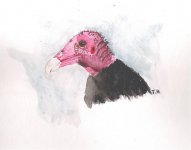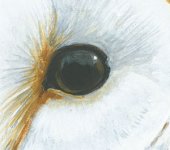tim.birdboy
Well-known member
I was inspired to paint the bare, pink head of the Turkey Vulture, after watching a vultures head, and white beak tip, glow brightly as the sun hit them. I really do not know why people consider them "ugly", they are very beautiful, in my mind.
I realize that the ear-lobe shouldn't be so blood-red, and that the small-amount of body shown should show more feather-detail. And the pupil should be clearer. Any other suggestions?
Hmmm, this scan was better than the Elegant Trogon.
EDIT: The head is a pink-lemonade color in real-life, not so purple. I take that back about the scan...
I realize that the ear-lobe shouldn't be so blood-red, and that the small-amount of body shown should show more feather-detail. And the pupil should be clearer. Any other suggestions?
Hmmm, this scan was better than the Elegant Trogon.
EDIT: The head is a pink-lemonade color in real-life, not so purple. I take that back about the scan...





